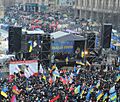Euromaidan facts for kids

Euromaidan was a series of big protests and public unrest in Ukraine. It started on November 21, 2013, with large gatherings in Maidan Nezalezhnosti (Independence Square) in Kyiv, the capital city.
The protests began because Ukraine's President, Viktor Yanukovych, suddenly decided not to sign an important agreement with the European Union. This agreement would have brought Ukraine closer to Europe. Instead, he chose to have closer ties with Russia. Ukraine's parliament had already agreed to the EU deal, but Russia had put pressure on Ukraine to reject it.
Over time, the protests grew much bigger. People started demanding that President Yanukovych and his government step down. They were upset about what they saw as widespread government corruption, unfair use of power, and human rights problems. They also disliked the influence of very rich and powerful businesspeople, known as oligarchs. The violent way police broke up protests on November 30, 2013, made people even angrier.
Euromaidan became the largest democratic movement in Europe since 1989. It eventually led to the 2014 event known as the Revolution of Dignity.
Contents
What Happened During Euromaidan?
Life in the Protest Camp
During the uprising, Independence Square (Maidan) in Kyiv became a huge protest camp. Thousands of people stayed there. They built makeshift barricades to protect themselves.
The camp had everything needed for a long protest. There were kitchens to cook food and first aid stations for anyone who got hurt. They also had broadcasting facilities to share their message. Stages were set up for speeches, lectures, debates, and performances.
The camp was guarded by groups called 'Maidan Self-Defense' units. These were volunteers who wore improvised uniforms and helmets. They carried shields and were armed with sticks, stones, and petrol bombs to defend the camp.
Protests Across Ukraine
While Kyiv was the main focus, protests also happened in many other parts of Ukraine. People across the country joined in to show their support.
In Kyiv, there were clashes with the police on December 1, 2013. Police also tried to clear the camp on December 11.
New Laws and More Clashes
Protests increased from mid-January 2014. This was because the government introduced very strict new laws against protesting. These laws made it much harder and more dangerous for people to demonstrate.
There were deadly clashes on Hrushevsky Street in Kyiv from January 19 to 22. Protesters then started taking over government buildings in many regions of Ukraine.
The uprising reached its most intense point from February 18 to 20. During these days, fierce fighting happened in Kyiv between the protesters and the police. Sadly, almost 100 protesters and 13 police officers died.
What Was the Outcome of Euromaidan?
After the intense fighting, President Yanukovych and the opposition leaders signed an agreement on February 21. This agreement aimed to create a temporary unity government, make changes to the constitution, and hold early elections.
Police left central Kyiv that afternoon. President Yanukovych and other government ministers then fled the city that evening. The very next day, the parliament removed Yanukovych from his position. A temporary government was then put in place.
Images for kids
-
Protesters in Kyiv, 29 December 2013
-
Opposition leaders Vitali Klitschko, Arseniy Yatsenyuk and Oleh Tyahnybok, addressing demonstrators, 27 November 2013
-
The largest pro-European Union protests outside Kyiv took place at the Taras Shevchenko monument in Lviv
-
Euromaidan in Munich
-
Self-defense of the Maidan
-
Petro Poroshenko addresses Euromaidan on 8 December 2013
-
Headquarters of the Euromaidan. At the front entrance there is a portrait of Stepan Bandera, a twentieth century Ukrainian nationalist.
See also
- Cold War II















